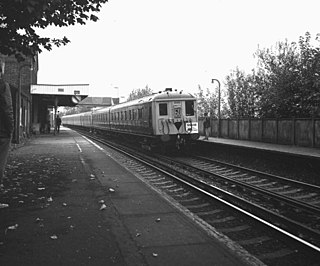
The Southern Railway (SR) gave the designation 2-BIL to the DC third rail electric multiple units built during the 1930s to work long-distance semi-fast services on the newly electrified lines from London to Eastbourne, Portsmouth and Reading. This type of unit survived long enough in British Rail ownership to be allocated TOPS Class 401.
The Lancashire and Yorkshire Railway (LYR) built suburban electric stock for lines in Liverpool and Manchester. The line between Liverpool to Southport began using electric multiple units (EMUs) on 22 March 1904, using a third rail 625 V DC. Additional trains were later built for this route, and in 1913 incompatible stock for the route to Ormskirk. Lightweight units were built to run on the Liverpool Overhead Railway.
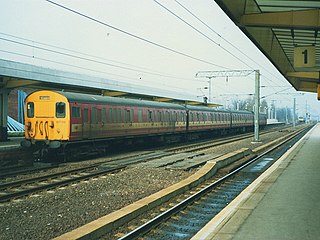
The British Rail Class 307 electric multiple units were built by BR at Eastleigh Works from 1954 to 1956. They were initially classified as AM7 before the introduction of TOPS.
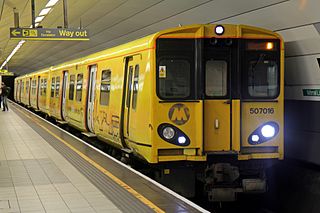
The British Rail Class 507 is a type of electric multiple-unit (EMU) passenger train built by British Rail Engineering Limited at Holgate Road carriage works in two batches from 1978 to 1980. They were the second variety of British Rail's standard 1972 design for suburban EMUs derived from PEP stock, which eventually encompassed 755 vehicles over five classes. They have worked on the Merseyrail network from new and continue to do so, having been refurbished by Alstom's Eastleigh Works. The Class 507 units are all now 42 or more years old.

The British Rail Class 508 electric multiple unit (EMU) passenger trains were built by British Rail Engineering Limited, at Holgate Road carriage works, York, in 1979–80. They were the fourth variant of BR's standard 1972 design for suburban EMUs, eventually encompassing 755 vehicles and five classes (313/314/315/507/508). They have worked mostly on the Merseyrail network since 1983 and continue to do so, having been refurbished by Alstom's Eastleigh Works. The Class 508 unit is now 43 years old.

The Wirral line is one of two commuter rail routes operated by Merseyrail and centred on Merseyside, England, the other being the Northern line.

The British Rail Class 504 was a unique type of electric multiple unit that ran on 1200 V DC third rail with side-contact current collection. All other mainline UK third rail has the electric "shoe" on top of the rail. The type was used only on the Bury Line between Manchester and Bury. They were built in 1959 at Wolverton Works, and the body was a standard type used for several electrification schemes of the time, but the high DC voltage through a side-contact third rail was unique in Britain. The trains replaced the previous 5-car units built by the Lancashire & Yorkshire Railway for the route, which had inaugurated this electrification scheme in 1916.
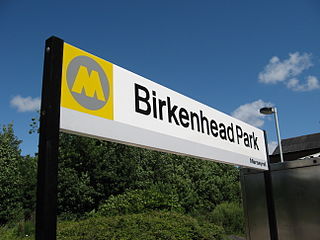
Birkenhead Park railway station is a two-platform through station situated in Birkenhead, Wirral, England. It lies on the Wirral Line 3+1⁄2 miles (5.6 km) west of Liverpool Lime Street on the Merseyrail network.

The British Rail Class 501 electric multiple units were built in 1955/56 for use on the former LNWR/LMS suburban electric network of the London Midland Region. A total of 57 three-car units were built.

British Rail Class 503 trains were 65 mph (105 km/h) electric multiple units. They were introduced in two batches. The first were in 1938, by the London, Midland and Scottish Railway (LMS) with a further batch in 1956 by the then nationalised British Railways (BR). When introduced by the LMS, they were officially known as Class AM3. They were designed for, and operated on, the Wirral & Mersey lines from Liverpool to West Kirby, New Brighton, and Rock Ferry. There were few places on their network of closely spaced stations to attain their maximum speed, except for the open section between Moreton and Meols. All but one set were withdrawn and scrapped by 1985. The final set was used on special Merseyrail services until 1988, and this preserved set was kept at the Electric Railway Museum near Coventry until moved to the Locomotive Storage Ltd warehouse at Margate.

The British Rail Class 302 was a type of electric multiple unit (EMU) introduced between 1958 and 1960 for outer suburban passenger services on the London, Tilbury and Southend line. This class of multiple unit was constructed using the Mark 1 bodyshell and was slam-door.
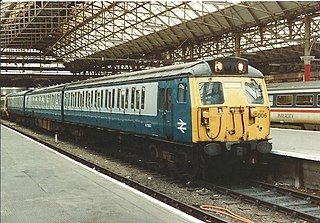
The British Rail Class 304 were AC electric multiple units designed and produced at British Rail's (BR) Wolverton Works.

British Railways Class 505 were 1,500 V DC electric multiple units (EMUs) introduced in 1931 by the Manchester, South Junction and Altrincham Railway (MSJAR). Although assigned to TOPS Class 505 by British Railways, these units were withdrawn before the TOPS numbering system came into common use for multiple units, and the Class 505 designation is very rarely used.

The British Rail Class 506 was a 3 carriage Electric Multiple Unit (EMU) built for local services between Manchester, Glossop and Hadfield on the Woodhead Line, which was electrified in 1954 on the 1,500 V DC overhead system.
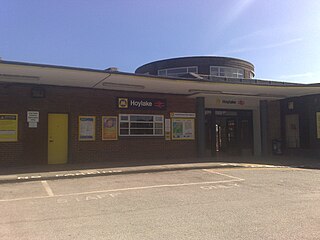
Hoylake railway station serves the town of Hoylake, Wirral, England. It lies on the West Kirby branch of the Wirral Line, part of the Merseyrail network. The station also offers free car parking facilities at all times.
Hall Road TMD was a railway traction maintenance depot situated adjacent to Hall Road railway station, Merseyside, England. The depot was a facility for storage and servicing of Merseyrail multiple units and rolling stock. It had two shed roads and four additional siding tracks; each road had capacity for three Class 507 or Class 508 electric multiple unit (EMU) sets . The depot code was HR.
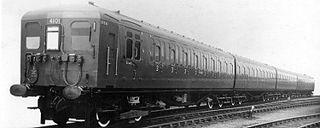
The Southern Railway (SR) and the British Railways used the designation Sub to cover a wide variety of electric multiple units that were used on inner-suburban workings in the South London area. The designation ‘Sub’ was first officially used in 1941 to refer to newly built 4-car units. However, during the 1940s large numbers of earlier ‘3-Car Suburban Sets’ were increased to four cars by the addition of an 'Augmentation' trailer, and became part of the 4-Sub category. The SR and BR (S) continued to build or else rebuild 4-car units to slightly different designs which became part of the 4-Sub Class. Many of these later examples survived in passenger use until late 1983, by which time British Rail had allocated to them TOPS Class 405.

Mersey Railway electric multiple units were electric multiple units introduced on the underground Mersey Railway, now a part of Merseyrail, in 1903. In the early 1900s the railway was bankrupt as it used steam locomotives that left a dirty atmosphere in the tunnel and passengers preferred the ferries. However, the railway was rescued by Westinghouse Electric, who electrified the railway and provided the first electric multiple units. The cars were supplemented in 1908, 1923 and 1925 and finally in 1936 to allow the progression from 4-car, through 5-car, and finally to 6-car trains. In 1938, when the Wirral Railway was electrified, the units were modified to allow through running between the two systems. In 1956–57 the cars were replaced by units similar to those used on the Wirral Railway.

LMS electric units were built in 1926–32 by the London, Midland and Scottish Railway (LMS) for use on the Liverpool to Ormskirk line and the DC lines in north London, all in England. Having inherited systems with DC electrification, the LMS built a number of new 3-car electric multiple units. The trains were withdrawn in 1963 and 1964.
Southport MPD is a former LMS railway depot located in the town of Southport, Merseyside.

















